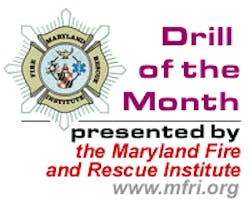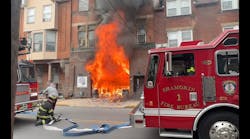The individual will demonstrate a basic understanding of the principles of strategy and tactics and their application on a structural fire incident.
Session Reference: 1
Topic: Basic Strategy And Tactics
Level of Instruction: N/A
Time Required: 3 Hours
Materials:
• Appropriate audio visual materials
References:
• Fire Department Company Officer, 3rd Edition, IFSTA
• Chief Officer, 1st Edition, IFSTA
• Fireground Tactics, Emanuel Fried, H., Marvin Ginn Corporation
• Fire Attack 1 & 2, Warren Y. Kimball, NFPA
• Firefighting Tactics, Lloyd Layman, NFPA
• NFPA 1410, Standard on Training For Initial Emergency Scene Operations (2000 Edition)
Preparation
Motivation: Initially employed strategy and tactics set the tone for the entire incident and can be the roadmap for a successful or unsuccessful outcome. Underlying any strategic plan or tactical decisions must be the safety of operating personnel. The quality of the effort is irrelevant if there is a serious firefighter injury or a firefighter fatality.
Objective (SPO): The individual will demonstrate a basic understanding of the principles of strategy and tactics and their application on a structural fire incident.
Overview: Basic Strategy And Tactics
• Introduction
• Priorities
• Resources
• Fire Attack
• Support Services
Instructors Notes: This drill is designed to address overall emergency scene planning and deployment of resources. While it does address specific tactics or tasks to be accomplished, it does not address the skills required to perform those tasks. Individuals participating in the drill should have some knowledge of what is required to perform the skills.
Basic Strategy And Tactics
SPO 1-1 The individual will demonstrate a basic understanding of the principles of strategy and tactics and their application on a structural fire incident.
EO 1-1 Demonstrate an understanding of the terms strategy and tactics and how they are applied to a structural fire incident.
EO 1-2 Demonstrate an understanding of the priorities that are used to develop a strategic plan make tactical decisions at a structural fire incident.
EO 1-3 Demonstrate an understanding of the resources needed to successfully suppress a fire in a structure.
EO 1-4 Demonstrate an understanding of the fire attack requirements to successfully suppress a structure fire.
EO 1-5 Demonstrate an understanding of the support services needed to support a structural fire attack.
Instructional Guide
I. INTRODUCTION (EO 1-1)
• Definition
• Strategy - an overall plan for controlling an incident or situation and describing how, in general terms, the operation will be conducted
• Tactics - action or actions taken to achieve the chosen strategy; also known as a tactical objective
• Strategic plan or incident action plan - plan created for a specific incident based on priorities and tactical objectives
• Application of definitions
• Strategy is a broad, general statement of the overall outcome to be achieved.
• Based on the department's standard operating guidelines
• Dictated by the priorities of life safety, incident stabilization, and property conservation
• Tactics involve the deployment and direction of resources (apparatus and personnel) at an incident
• Tactics are applied to achieve the strategy
• Involves specific tasks such as search and rescue or specific locations such as a roof
• Strategic plan or incident action plan addresses what is to be done, who will done, when it will be done, where it will be done, and how it might be done
• Plans are specific to the incident
• May be built around standard operating procedures
II. PRIORITIES (EO 1-2)
• Priorities fall into two categories that are integrated
• Incident priorities
• Life safety
• Incident stabilization
• Property conservation
• Tactical priorities (RECEO-V/S)
• Rescue
• Exposures
• Confinement
• Extinguishment
• Overhaul
• Ventilation
• Salvage
• Strategic and tactical priorities should be addressed in the order listed
• Risk analysis and firefighter safety have to be incorporated into the priorities
• Lives of firefighters should not be traded when there is little or no chance of saving a civilian
• A defensive or exterior attack should be considered when there are safety concerns about the integrity of a structure
• Consideration must be given to the amount of time that has elapsed in the burning process prior to the initiation of fire attack especially where truss type roof construction is involved (if the fire has been burning unhindered for at least 20 minutes, serious consideration should be given to operating in the defensive mode and out of the collapse zone)
III. RESOURCES (EO 1-3)
• There must be sufficient apparatus and personnel responding on the initial alarm to safely initiate the initial fire attack (it is easier to return units that are not needed than to have to call for assistance after arrival on the scene and have to wait for them)
• Additional resources may be called upon when the incident overwhelms the initial alarm (second alarm)
• Apparatus responding on the initial alarm should include units and personnel to supply and apply water (protect exposure, confine fire, extinguish fire, and overhaul), units and personnel to perform the support duties (search and rescue, ventilation, salvage, ladders, lighting, and utility control)
• Resources must include an incident commander and a safety officer on any incident where units will be operating
• Provisions must be made for a rapid intervention team/crew to be in place and ready before personnel operate in an immediately dangerous to life and health (IDLH) environment
• Coverage should be provided for all sides of the structure
• Consideration should be given to having emergency medical services available on the scene
• For extended operations or extreme weather conditions, provisions need to be made for rehabilitation services and the rotation of personnel
• Consideration should be given to having extra uncommitted units and personnel in a staging area for deployment as needed
IV. FIRE ATTACK (EO 1-4)
• Before any fire attack begins, civilians in danger must be rescued and removed to safety
• Fire attack includes getting water from the source to the scene and being able to apply it in a timely and efficient manner
• There must be an ability to move sufficient quantities of water to meet fire flow needs
• Where units are operating outside the area of a pressurized water system, additional units may be needed to relay or shuttle water
• The initial attack line should provide a minimum flow of 100 gpm
• The backup line should provide a minimum flow of 200 gpm
• Every should be made to initiate the fire attack with 2 minutes of arrival on the scene and ready for attack
• The initial attack line should be directed at the fire
• A second line should be advanced to the area above the fire
• Additional lines may be needed for areas adjacent to the fire
• While the initial attack line for a residential structure may be 1-1/2-inch or 1-3/4-inch, these lines may not provide sufficient fire flow to overcome the heat production
• Consideration may need to be given to the use of 2-inch or larger lines or master streams for fire with high heat production (attack lines being used in ineffective in suppressing the fire) or for commercial or large residential structures
• It is better to apply large fire flows and put the fire out faster than lesser amounts and eventually put the fire out
V. SUPPORT SERVICES (EO 1-5)
• Search and rescue
• Although considered a support service, it is the responsibility of everyone especially the first arriving units
• May not be performed at all incidents but there must be an assurance that everyone has been removed to a place of safety
• Must be initiated before any other operations commence
• May include sheltering in place or relocation rather than removal
• Ventilation
• Needed whenever there is smoke in the structure
• Coordinate with fire attack
• Consider impact on fire spread through pre-mature initiation, improper placement, or type of building construction
• Consider stage of fire development (incipient, free burning, smoldering) as well as potential backdraft or flashover condition
• Consider placement and timing of ventilation in relation to objective (rescue or fire attack)
• Salvage
• Can be incorporated into initial attack where entry and water application involved
• Can be more than throwing covers (respect for the property of others and not causing more damage than the fire)
• Ladders
• Necessary to support rescue or fire attack efforts
• Use as secondary means of escape for personnel operating inside the structure above ground level or on a roof
• Should have at least two ladders in place when ladders being used (one for regular use and one for emergency escape should the escape path be cut off)
• Lighting
• Needed to improve the safety of the working area
• Should be considered for interior on any incidents and for exterior when it is not daylight
• Light the scene as well as specific work areas
• Do not place lights in places of heavy personnel traffic
• Utility control
• Necessary when utilities are contributing to the fire or may be an ignition source or safety hazard
• May include shutting off electricity from panel or shutting off natural gas at the meter (electric meter should not be removed or wires cut)
• May require assistance from utility company
At the conclusion of the above portion of the drill, consideration should be given to conducting a tabletop, simulation, or chalkboard exercise to apply the basic strategy and tactic principles to specific structures in the response area. This will be provide an opportunity to make sure that everyone understands the principles as well as share information about specific structures in the response area. There may be personal knowledge that would be beneficial to others in attendance.
Summary
Review: N/A
Basic Strategy And Tactics
• Introduction
• Priorities
• Resources
• Fire Attack
• Support Services
Remotivation: The development of the incident action plan and the implementation of that plan through various tactical decisions require the proper deployment of apparatus and personnel to bring the incident to a successful conclusion. While the fire will eventually go out, the effectiveness and efficiency with which that is accomplished is the result of a good strategic plan and tactics.






